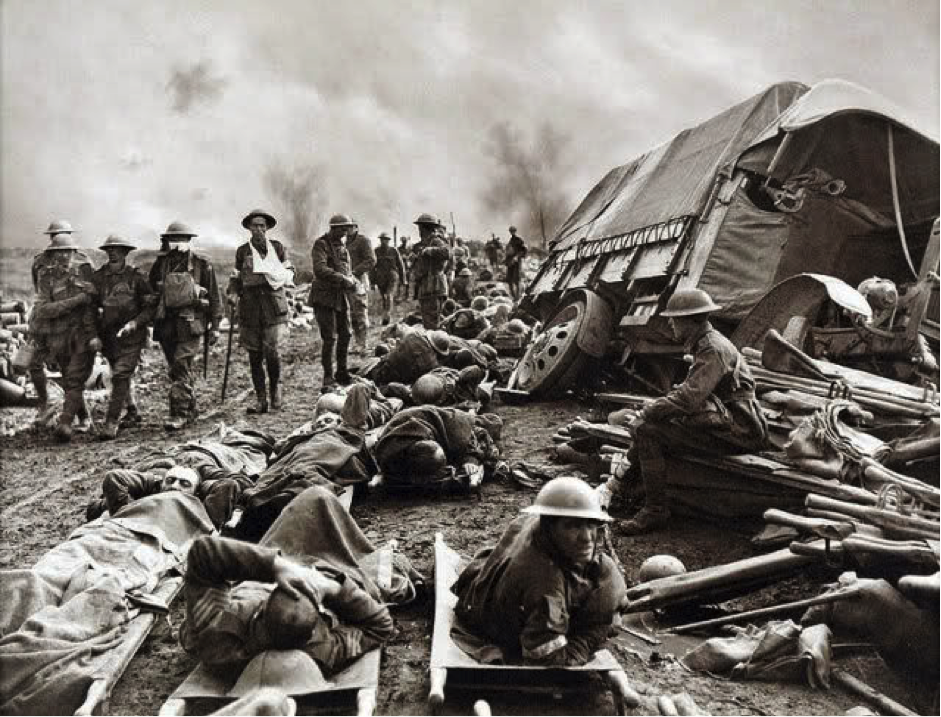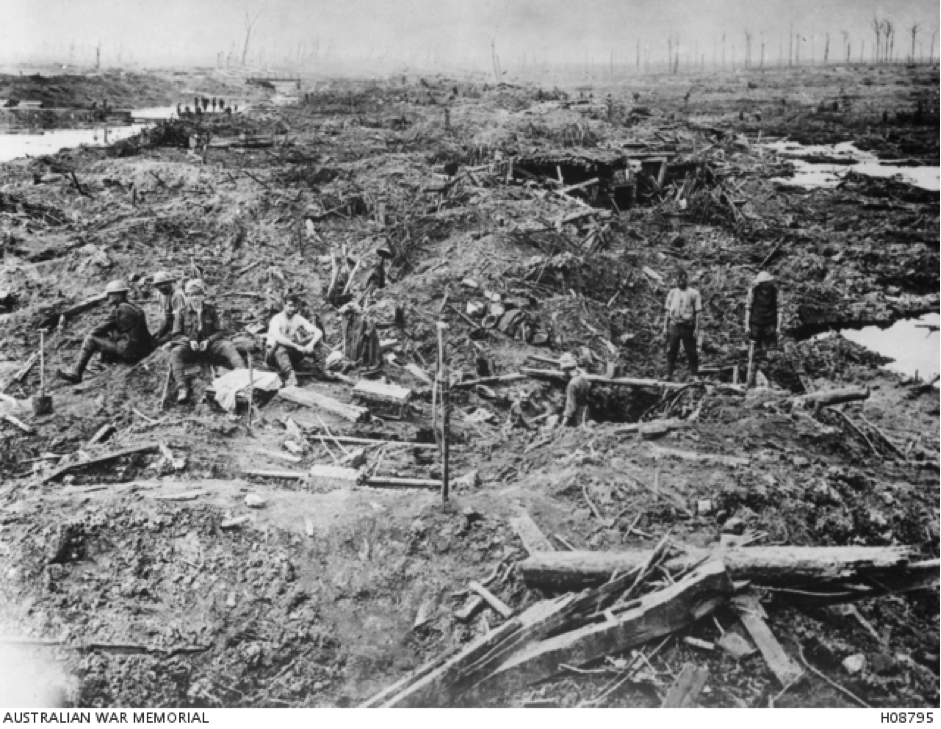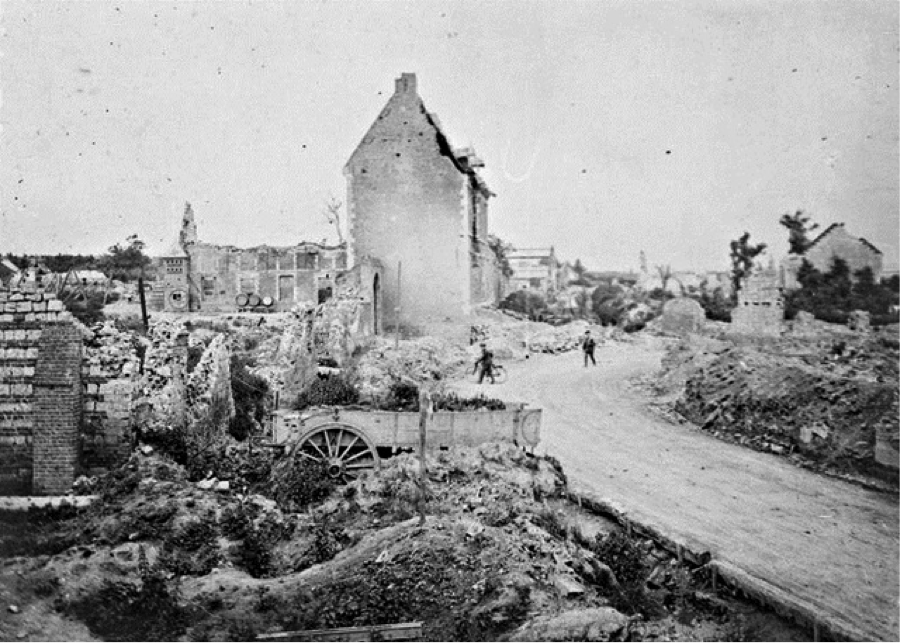3rd Battle of Ypres (Passchendaele) 1917

Wounded Australians, Menin Road, September 20th 1917 by official photographer James Hurley.
Battle of the Menin Road Ridge
September 9th – 26th
Better weather and extensive road repairs worked in the British favour before and during the Battle of the Menin Road Ridge. Well prepared attacks and effective use of a creeping barrage meant the British succeeded in capturing most of their objectives. It was the first involvement of Australian units (1st and 2nd AIF) in the 3rd Battle of Ypres. They sustained around 5000 casualties at Menin Road Ridge.
September 20th 1917. Death of John William Brewitt, 6th Australian Infantry Battalion, 2nd Brigade, 1st Division, Australian Imperial Force. He emigrated from Holme Pierepont, Notts. to farm in Australia, then enlisted with the AIF. He was wounded at the Battle of Poziéres but then re-joined his unit. He was killed at Menin Road Ridge but not posted as missing until after the Battle of Polygon Wood.
Other conflicts in the Ypres Salient
October 9th 1917, Elverdinghe: death of Gunner 113807 Charles Wightman Pike, 232nd Siege Battery, Royal Garrison Artillery, a law clerk from Walnut Grove, Radcliffe, who was married with two children. He was killed by the impact from an exploding shell while assisting a comrade to build a dug out (Information from De Ruvigny’s Roll of Honour). Died at Corps XVIII main dressing station near Elverdinghe, Ypres Salient, buried Solferino Farm, Brielen, age 34.
Battle of Poelcapelle
October 9th 1917
The battle was a defensive success for the Germans who recaptured much of the ground they had previously lost. Many wounded men were stranded on the battlefield due to the appalling conditions.
October 9th 1917, West Vlaanderen. Private 146 Joseph Hull, Machine Gun Guards, was killed in action, age 27. The Guards Division, XIV Corps, attacked enemy defences in front of Houlthost Forest during the night of October 9th. The Machine Gun Guards were in two groups, detailed to give overhead fire at short range on farm buildings. All objectives were taken. Three officers were killed but there is no record of the number of casualties from other ranks.
October 10th/11th. Death of Lt. William Lisle Rockley, 10th Battalion, York and Lancaster Regiment, 63rd Brigade, 37th Division, IX British Corps, 2nd Army. From July 1917, the 10th York and Lancaster Regiment fought throughout the 3rd Battle of Ypres and were present at the Battles of Pilckem Ridge, Menin Road Ridge, Polygon Wood, Broodseinde, Poelcapelle and Passchendaele. At the time of his death, William Rockley was acting adjutant. He was killed instantaneously by a shell when proceeding to the lines in the company of his CO and medical officer, the latter being dangerously wounded. His father, Lisle Rockley, created Rockley Memorial Park and its adjacent cliff walk in his memory.
The 1st Battle of Passchendaele took place on October 12th and was another attempt to gain the high ground around Passchendaele. Nearly a thousand New Zealand casualties were killed, wounded or stranded in the mud.
2nd Battle of Passchendaele
October 26th – November 10th 1917
How Radcliffe servicemen died
Radcliffe Servicemen and British Army
1914 Retreat from Mons
1914 Battle of the Marne, 1st Battle of Ypres
1915 Battle of Neuve Chapelle, Aubers Ridge
1915 Gallipoli
1915 2nd Battle of Ypres and other conflicts
1916 Conflicts prior to the Somme
1916 Battle of the Somme July
1916 Battle of the Somme August
1916 Battle of the Somme Autumn
1917 Battle of Arras
1917 3rd Battle of Ypres
1917 3rd Battle of Ypres (Passchendaele)
1918 German Spring Offensive
1918 3rd Battle of the Aisne
1918 HMS Leasowe Castle torpedoed
1918 Last 100 Days, 5th Battle of Ypres
1918 Final Days
1918 The Armistice

British Army soldiers, presumed Sherwood Foresters, between Passchendaele and Boesinghe
(source Derby Telegraph, March 16th 2014)
The battle saw the final attack in the 3rd Battle of Ypres and capture of the high ground of Passchendaele. The Canadian Corps relieved the exhausted ANZACS and pressed forward to the town. The battle was fought in a series of stages. On October 30th, the troops were divided into a northern and southern flank with the aim of gaining a base from which to attack Passchendaele. The 63rd Division, on the southern flank, was trapped in the mud as they advanced and caught by German machine guns.
October 30th 1917, Ypres Salient. Death of Private 763130 Frederick Malsom, London Regiment (Artists Rifles), 63rd (Royal Naval) Division, who lived in Radcliffe, was killed in action, age 19 or 20. On October 7th the Artists Rifles were in training at Houtkerque farm, close to the Belgian border, until October 25th. They proceeded to Dombre Camp then Reigersberg Camp arriving there on October 27th.
From the War Diary of 1/28th County of London Regiment (Artists Rifles)
27.10.17: Advance party reported to Nelson Battalion at Irish Farm and went to the line at Albatross Farm
28.10.17: Battalion went into the line HQ at Albatross Farm taking over from Nelson Battalion.
29.10.17: Albatross Farm. In the line
30.10.17: 5.50 pm. Battalion attacked
31.10.17: Relieved by Nelson Battalion and returned to Irish Farm. Total estimated casualties for the period 28th – 31st: officers killed 6, wounded 4, other ranks killed 70, wounded 130. Missing 124.
1.11.17: Battalion moved to Poperinghe by rail, where it was joined by transport.
A report cited in the Nottinghamshire Great War Roll of Honour (original source not given) described the action in the vicinity of Albatross Farm as follows:
‘A’ Company of the Artists’ Rifles were wiped out when attacking Source Trench (which lay near a little stream then in flood called the Paddebeek) where enemy machine guns picked their targets among men held in the knee high suck of the mud.’ (from Nottinghamshire Great War Roll of Honour)
The capture of Passchendaele marked the end of the campaign in the Ypres Salient. The British diverted their resources after the rout of the Italian army at Caporetto (October 24th-November 12th 1917).
Other 1917 deaths
November 26th 1917, Roclincourt. Death of Gunner 63959 Thomas Birkby, Royal Field Artillery, 95th Brigade, 21st Division. Buried at the village of Roclincourt, just north of Arras, age 24. He was a bricklayer living in Radcliffe.

Ruins of Roclincourt. Image no. Q69006, courtesy of Imperial War Museum
